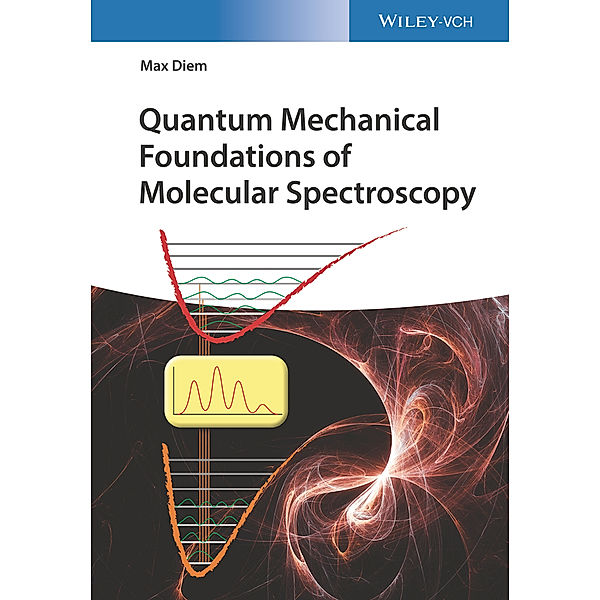Quantum Mechanical Foundations of Molecular Spectroscopy
(Sprache: Englisch)
The textbook introduces the quantum mechanical fundamentals of a multitude of spectroscopic methods that every student and practitioner need to know.
Leider schon ausverkauft
Buch (Kartoniert)
- Lastschrift, Kreditkarte, Paypal, Rechnung
- Kostenlose Rücksendung
Produktdetails
Produktinformationen zu „Quantum Mechanical Foundations of Molecular Spectroscopy “
Klappentext zu „Quantum Mechanical Foundations of Molecular Spectroscopy “
The textbook introduces the quantum mechanical fundamentals of a multitude of spectroscopic methods that every student and practitioner need to know.
Inhaltsverzeichnis zu „Quantum Mechanical Foundations of Molecular Spectroscopy “
Preface Introduction 1 TRANSITION FROM CLASSICAL PHYSICS TO QUANTUM MECHANICS 1.1 Description of Light as a Wave 1.2 Black Body Radiation 1.3 Photoelectric Effect 1.4 H-Atom Absorption and Emission 1.5 Molecular Spectroscopy 1.6 Summary 2 PRINCIPLES OF QUANTUM MECHANICS 2.1 Postulates of Quantum Mechanics 2.2 Potential Energy and Potential Functions 2.3 Demonstration of Quantum Mechanical Principles for a Simple, One-Dimensional, One-Electron Model System: The Particle-in-a-Box ("PiB") 2.4 Two-Dimensional PiB, the Unbound Particle, and the PiB with Finite Energy Barriers 2.5 Real-World PiBs: Poly-Enes, Quantum Dots and Quantum Cascade Lasers 3 PERTURBATION OF STATIONARY STATES BY ELECTROMAGNETIC RADIATION 3.1 Time Dependent Perturbation Treatment of Stationary State Systems by EM Radiation 3.2 Dipole-Allowed Transition and Selection Rules for the PiB 3.3 Einstein Coefficients for the Absorption and Emission of Light 3.4 Lasers 4 THE HARMONIC OSCILLATOR, A MODEL SYSTEM FOR THE DIATOMIC MOLECULES 4.1 The Harmonic Oscillator Schrödinger Equation, Energy Eigenvalues and Wave Functions 4.2 The Transition Moment for the Harmonic Oscillator 4.3 Real Diatomic Molecules, Anharmonicity 4.4 Infrared Absorption Spectroscopy of Diatomic Molecules 5 VIBRATIONAL INFRARED AND RAMAN SPECTROSCOPY OF POLYATOMIC MOLECULES 5.1 Vibrational Energy of Polyatomic Molecules 5.2 Transition Moments and Symmetry-Based Selection Rules in Absorption 5.3 Polarizability, Raman Scattering and Symmetry-Based Selection Rules in Scattering 5.4 Practical Infrared and Raman Spectroscopy 6 ROTATION OF RIGID MOLECULES: ROTATIONAL SPECTROSCOPY 6.1 Classical Rotational Energy 6.2 Quantum Mechanics of Rotational Spectroscopy, Selection Rules 6.3 Rot-Vibrational Transitions 7 H ATOM AND MANY-ELECTRON ATOMS 7.1 Eigenfunctions, Eigenvalues and Orbitals for the Hydrogen Atom 7.2 Many Electron Atoms, Slater Orbitals, and the Periodic Chart 7.3 Atomic Spectra 8 ELECTRONIC STATES AND SPECTROSCOPY OF POLYATOMIC
... mehr
MOLECULES 8.1 Electronic Energy Levels of Polyatomic Molecules 8.2 Ultraviolet and Visible Spectroscopy of Polyatomic Molecules 9 INTERACTION OF ELECTRONIC AND VIBRATIONAL ENERGY LEVELS 9.1 Introduction to Vibronic Theory 9.2 Fluorescence Spectroscopy 9.3 Recent Advances and Biological Applications of Fluorescence Spectroscopy 10 SPIN STATES AND SPIN SPECTROSCOPY 10.1 The Angular Momentum Operator Revisited, and Spin States 10.2 Transitions Between Spin States 10.3 Basic Nuclear Magnetic Resonance Spectroscopy Appendix I. Constants and Their Numerical Values Appendix II. Mathematical Principles Appendix III. Perturbation Methods Appendix IV. Group Theory Appendix V. Fourier Transforms and Fourier Transform Spectroscopies
... weniger
Autoren-Porträt von Max Diem
Professor Max Diem is based in the Department of Physical and Biophysical Chemistry at Northeastern University. He did his first degree at the University of Karlsruhe and then his PhD at the University of Toledo in OH. Until 2005 he was at the Central University of New York before moving to Northeastern University. His research interests are is centered on the development of physical / optical methods for medical diagnosis in tissue diagnostics.
Bibliographische Angaben
- Autor: Max Diem
- 2021, 1. Auflage, 288 Seiten, Maße: 17 x 24,4 cm, Kartoniert (TB), Englisch
- Verlag: Wiley-VCH
- ISBN-10: 3527347925
- ISBN-13: 9783527347926
- Erscheinungsdatum: 28.04.2021
Sprache:
Englisch
Kommentar zu "Quantum Mechanical Foundations of Molecular Spectroscopy"
0 Gebrauchte Artikel zu „Quantum Mechanical Foundations of Molecular Spectroscopy“
| Zustand | Preis | Porto | Zahlung | Verkäufer | Rating |
|---|





Schreiben Sie einen Kommentar zu "Quantum Mechanical Foundations of Molecular Spectroscopy".
Kommentar verfassen